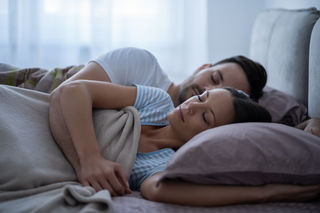Sleep
Trouble Sleeping? You Can Blame Your Bed Partner
New research reveals how sharing the bed affects sleep quality.
Posted April 25, 2020 Reviewed by Lybi Ma

Results from a new study show that sharing your bed might lead to disrupted sleep—especially if you and your partner go to bed at the same time. Previous research had shown that bed partners’ awakenings tend to wake up the other person relatively often—on average, about one out of three wake-ups are caused by one’s partner.
The effects may be more pronounced for women, who spend a greater proportion of time in bed awake when sharing the bed, whereas the average man gets more sleep when they have a bed partner versus sleeping alone.
In this new study, the researchers recruited adult couples without sleep disorders like insomnia, and monitored their sleep for seven nights, using both actigraphy (which measures movement, like a Fitbit) and participants’ self-reports. They used these measurements to calculate variables that are perhaps easiest to understand by imagining you were a participant in the study. They included:
- The percentage of time you and your partner were both awake
- The percentage of time you and your partner were both asleep
- The number of times you were woken up by your partner
- The percentage of your wake-ups that were caused by your partner
- The percentage of your partner’s wake-ups that caused you to also wake up
- The percentage of time when your partner was awake that you stayed asleep
The research team was also interested in whether going to bed at the same time would affect the degree to which bed partners disrupted each other’s sleep. They expected a shared bedtime to lead to less partner sleep disruption, since many couples prefer to go to bed at the same time and therefore may find it leads to better sleep.
Results
Overall the researchers found that partners were both asleep 67% of the time, and both awake 7% of the time. Together these data show that bed partners were in the same state (wake or sleep) about 74% of the time they were in bed, and were mismatched (one partner awake, the other asleep) about one-quarter of the time.
On average, partners woke each other up six times throughout the night. If one partner woke up, there was an approximately 20% chance the other would also wake up; similarly, about 20% of one partner’s wake-ups were caused by the other partner’s awakenings. Finally, participants were able to stay asleep for about half of the time their partner was awake.
These findings suggest that partners significantly affect each other’s sleep. It’s important to note that they may not be aware of all of these wake-ups, since they were measured by movement and not by subjective report.
The results also showed that “night owls” in a couple—those who go to bed later and wake up later than their partner—were less likely to be woken up by their partner’s awakenings.
Effect of Shared Bedtime
Contrary to the researchers' expectations, partners were more likely to wake each other up when they shared the same bedtime. These awakenings were most likely in the first two hours of being in bed and the last two hours of the night.
The study authors note that there must be other benefits from going to bed at the same time, including “moments of physical or emotional connection,” that offset the sleep disruption, since many couples prefer to be on the same sleep schedule.
It’s important to note an alternative explanation for why a shared bedtime leads to more shared wake-ups. The authors explain that perhaps the partners have synchronized sleep phases, they’re waking up independently at the same time. All of us cycle through the stages of sleep multiple times each night, descending into deeper stages and then ascending to lighter stages and REM periods, with brief awakenings throughout one’s time in bed.
Therefore what looks like one partner waking up the other could be a coincidence based on starting their sleep cycles at approximately the same time. Actigraphy-based data can’t rule out this alternative explanation since actigraphs only measure movement; researchers would need to use polysomnography to measure brain to see if individuals are waking up on their own versus being woken up by their partner.
The actigraphy data also can’t detect when a person is awake but motionless, which would result in missing wake-ups. Polysomnography data could also solve this limitation.
Finally, we can’t know from this study whether participants would sleep better alone versus with their partner. Future studies might compare individuals when they’re co-sleeping versus sleeping alone.
For now, you can totally blame your partner for less-than-ideal sleep. If they ask you how you slept last night, tell them they probably woke you up six times. Just don’t mention you probably did the same to them.
Facebook image: wavebreakmedia/Shutterstock
References
Walters, E. M., Phillips, A. J., Boardman, J. M., Norton, P. J., & Drummond, S. P. (2020). Vulnerability and resistance to sleep disruption by a partner: A study of bed-sharing couples. Sleep Health.




